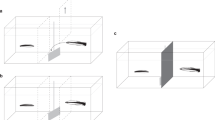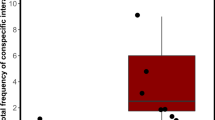Abstract
Service providers may vary service quality depending on whether they work alone or provide the service simultaneously with a partner. The latter case resembles a prisoner’s dilemma1,2,3,4, in which one provider may try to reap the benefits of the interaction without providing the service. Here we present a game-theory model based on the marginal value theorem5, which predicts that as long as the client determines the duration, and the providers cooperate towards mutual gain, service quality will increase in the pair situation. This prediction is consistent with field observations and with an experiment on cleaning mutualism, in which stable male–female pairs of the cleaner wrasse Labroides dimidiatus repeatedly inspect client fish jointly. Cleaners cooperate by eating ectoparasites6 off clients but actually prefer to cheat and eat client mucus7. Because clients often leave in response to such cheating, the benefits of cheating can be gained by only one cleaner during a pair inspection. In both data sets, the increased service quality during pair inspection was mainly due to the smaller females behaving significantly more cooperatively than their larger male partners. In contrast, during solitary inspections, cleaning behaviour was very similar between the sexes. Our study highlights the importance of incorporating interactions between service providers to make more quantitative predictions about cooperation between species.
This is a preview of subscription content, access via your institution
Access options
Subscribe to this journal
Receive 51 print issues and online access
$199.00 per year
only $3.90 per issue
Buy this article
- Purchase on Springer Link
- Instant access to full article PDF
Prices may be subject to local taxes which are calculated during checkout



Similar content being viewed by others
References
Axelrod, R. & Hamilton, W. D. On the evolution of co-operation. Science 211, 1390–1396 (1981)
Nowak, M. A. & Sigmund, K. Tit for tat in heterogeneous populations. Nature 355, 250–253 (1992)
Nowak, M. & Sigmund, K. A strategy of win-stay, lose-shift that outperforms tit-for-tat in the prisoner’s dilemma game. Nature 364, 56–58 (1993)
Dugatkin, L. A. Cooperation Among Animals: An Evolutionary Perspective (Oxford Univ. Press, 1997)
Charnov, E. L. Optimal foraging, the marginal value theorem. Theor. Popul. Biol. 9, 129–136 (1976)
Grutter, A. S. Parasite removal rates by the cleaner wrasse Labroides dimidiatus . Mar. Ecol. Prog. Ser. 130, 61–70 (1996)
Grutter, A. S. & Bshary, R. Cleaner wrasse prefer client mucus: support for partner control mechanisms in cleaning interactions. Proc. R. Soc. Lond. B 270 (Suppl.). S242–S244 (2003)
Noë, R., Van Schaik, C. P. & Van Hooff, J. A. R. A. M. The market effect: an explanation for pay-off asymmetries among collaborating animals. Ethology 87, 97–118 (1991)
Noë, R. & Hammerstein, P. Biological markets. Trends Ecol. Evol. 10, 336–339 (1995)
Bowles, S. & Hammerstein, P. in Genetic and Cultural Evolution of Cooperation (ed. Hammerstein, P.) 153–165 (MIT Press, 2003)
Pierce, N. E. et al. The ecology and evolution of ant associations in the Lycaenidae (Lepidoptera). Annu. Rev. Entomol. 47, 733–771 (2002)
Kiers, E. T., Rousseau, R. A., West, S. A. & Denison, R. F. Host sanctions and the legume–rhizobium mutualism. Nature 425, 78–81 (2003)
Côté, I. M. Evolution and ecology of cleaning symbioses in the sea. Oceanogr. Mar. Biol. Ann. Rev. 38, 311–355 (2000)
Grutter, A. S. Relationship between cleaning rates and ectoparasite loads in coral reef fishes. Mar. Ecol. Prog. Ser. 118, 51–58 (1995)
Bshary, R. & Grutter, A. S. Punishment and partner switching cause cooperative behaviour in a cleaning mutualism. Biol. Lett. 1, 396–399 (2005)
Bshary, R. & Grutter, A. S. Image scoring and cooperation in a cleaner fish mutualism. Nature 441, 975–978 (2006)
Johnstone, R. A. & Bshary, R. From parasitism to mutualism: partner control in asymmetric interactions. Ecol. Lett. 5, 634–639 (2002)
Robertson, D. R. Social control of sex reversal in a coral-reef fish. Science 177, 1007–1009 (1972)
Bshary, R. & Grutter, A. S. Asymmetric cheating opportunities and partner control in a cleaner fish mutualism. Anim. Behav. 63, 547–555 (2002)
Heinsohn, R. & Packer, C. Complex cooperative strategies in group-territorial African lions. Science 269, 1260–1262 (1995)
Milinski, M. TIT FOR TAT in sticklebacks and the evolution of cooperation. Nature 325, 433–435 (1987)
Dugatkin, L. A. Do guppies play TIT FOR TAT during predator inspection visits? Behav. Ecol. Sociobiol. 23, 395–399 (1988)
Bshary, R. & Schäffer, D. Choosy reef fish select cleaner fish that provide high-quality service. Anim. Behav. 63, 557–564 (2002)
Hammerstein, P. Why is Reciprocity so Rare in Social Animals? A Protestant Appeal in Genetic and Cultural Evolution of Cooperation (ed. Hammerstein, P.) 83–93 (MIT Press, 2003)
Clutton-Brock, T. H. & Parker, G. A. Punishment in animal societies. Nature 373, 209–215 (1995)
Clutton-Brock, T. H. & Parker, G. A. Sexual coercion in animal societies. Anim. Behav. 49, 1345–1365 (1995)
Dreber, A., Rand, D. G., Fudenberg, D. & Nowak, M. A. Winners don’t punish. Nature 452, 348–351 (2008)
Bshary, R. & Würth, M. Cleaner fish Labroides dimidiatus manipulate client reef fish by providing tactile stimulation. Proc. R. Soc. Lond. B 268, 1495–1501 (2001)
Acknowledgements
We thank the Egyptian Environmental Affairs Agency for permission to work at Ras Mohammed National Park, the Park Rangers and I. Riepl for local support, and M. Würth and A. Hubl for field assistance. We further thank the Lizard Island Research Station for their support concerning the experiments. R.B. was funded by the Natural Environment Research Council and by the Swiss Science Foundation. A.S.T.W. was funded by the Swiss Science Foundation. A.S.G. was funded by the Australian Research Council. O.L. was funded by the Swedish Research Council.
Author Contributions R.B. and A.S.G. were responsible for the experimental data; A.S.T.W. was responsible for the field data; O.L. was responsible for the model; and R.B., A.S.G. and O.L. contributed to the writing.
Author information
Authors and Affiliations
Corresponding author
Supplementary information
Supplementary Information
The file contains Supplementary Notes on the model of cleaner-client interactions. Equations (1) and (2) in the main text are derived and an important qualitative prediction of the model is demonstrated: cooperative pairs of cleaner fish provide higher service quality than singletons. (PDF 86 kb)
Rights and permissions
About this article
Cite this article
Bshary, R., Grutter, A., Willener, A. et al. Pairs of cooperating cleaner fish provide better service quality than singletons. Nature 455, 964–966 (2008). https://doi.org/10.1038/nature07184
Received:
Accepted:
Issue Date:
DOI: https://doi.org/10.1038/nature07184
This article is cited by
-
Children as assessors and agents of third-party punishment
Nature Reviews Psychology (2022)
-
Cleaner fish are sensitive to what their partners can and cannot see
Communications Biology (2021)
-
Current strength, temperature, and bodyscape modulate cleaning services for giant manta rays
Marine Biology (2020)
-
Testosterone causes pleiotropic effects on cleanerfish behaviour
Scientific Reports (2019)
-
Lack of strategic service provisioning by Pederson’s cleaner shrimp (Ancylomenes pedersoni) highlights independent evolution of cleaning behaviors between ocean basins
Scientific Reports (2019)
Comments
By submitting a comment you agree to abide by our Terms and Community Guidelines. If you find something abusive or that does not comply with our terms or guidelines please flag it as inappropriate.



